
The swords from the Bronze Age represent some of the finest work of the bronze smiths 3000 years ago, and in books, archaeologists encompass it with a few simple words ‘they made moulds of clay and cast swords’.
Today the casting of a sword has become a bit of a holy grail, by many others, and myself even though some of the results are quite good, they always fall far short of the quality and elegance of those of the Bronze Age metal workers. Why could it be the bronze smiths who cast the swords 3000 years ago were absolute masters; with a lifetime’s accumulation of experience and skill, some of it passed down over the years, possibly from father to son or an apprenticeship.
One of the first things you notice if you look at Bronze Age metal work, is that blade length was always at the edge of casting technology, and even from the early Bronze Age, bronze daggers had their handles riveted on, so all the casting length was in the blade.
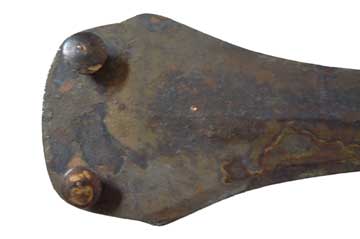
As the early Bronze Age metal worker developed his skill in casting daggers using both clay and stone moulds, he managed to push the blades longer. From the middle Bronze Age these blades, some of them over 24 inches in length, are known as rapiers: the blades tend to be very narrow and the handles are still riveted on. in the past it was assumed these long narrow stabbing blades were not very successful in battle, and were more likely worn as symbols of rank. However more recent work has shown these were very efficient weapons.

The Figsbury Ring sword (above) and a similar reproduction (below).
Recently research on blade damage has pointed to some of the damage being deliberately inflicted by other blades, possibly from battle, but it’s also possible that swords were ritually broken or “killed” on the death of their owner.
One other major step in technology, which is often overlooked, is the forging of blade edges. This starts with the early Bronze Age with the arrival of beaker copper blades, probably done with hand held stone tools. But the work on later bronze daggers 2000BC is so incredibly neat that they must have been done with bronze anvils set in guides with the blades being drawn between them whilst being hammered. This style of Recasso edging continues in nearly all bronze edged weapons throughout the Bronze Age including spears.
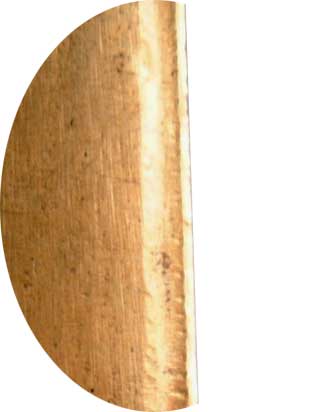
Experiments in edge forging
The copper alloy used in later swords seems to rotate around 8-9% tin and 1-3% lead; it’s generally assumed the lead was added to improve the flow of the bronze for difficult castings. Indeed some of the Wilburton swords have very narrow section handles, which would make it difficult to get bronze though to fill the mould. The later Ewart Park swords have slightly thicker section in the handle, which must have improved things. All swords were cast through the handle, whereas rapiers could be cast from either end when cast in stone moulds.
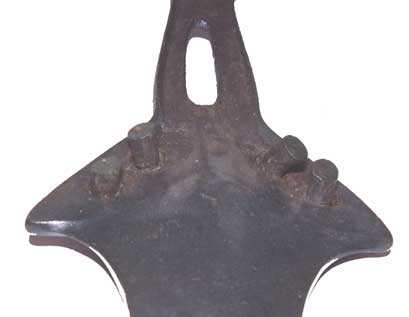
Those of us that have used leaded bronze find it particularly messy and would tend to add more tin rather than lead. Maybe it’s because of the need to forge the blade, which would become increasingly difficult with a higher tin content. Also the anvils needed to forge the blades would be limited to 12 % tin otherwise they would possibly become too brittle.
The casting evidence from the middle bronze age is almost entirely stone moulds for rapiers, and one of the advantages of a stone mould is that it is reusable, but we do not get identical blades. I wonder if, in areas where a suitable stone was not available, they would have had to use clay moulds as an alterative, which would explain the uniqueness of each blade.
The demand for a more effective weapon must have pushed the development of rapiers towards a leaf shape blade, but still with the inherent weakness of riveted handles. It seems likely the arrival of imports from Europe in the beginning of the late Bronze Age had an effect on sword designs, and local bronze smiths were put under pressure to copy these new swords with integral handles.
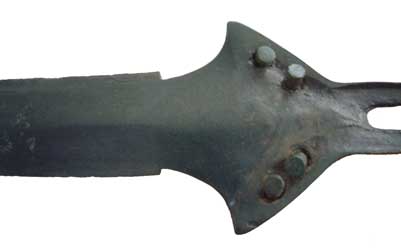
Early swords with integral handles, both imports and indigenous, are very similar in design, with wide blades, strong points and handles, making an effective slashing and stabbing weapon. It would be easy to draw comparisons with the early Greek warriors, with swords and shields fighting in great phalanxes, but I think this is unlikely as the number of swords is comparatively small.

Reproduction of The Ewart Park sword
This sword (as an unfinished casting) is available for sale.
If you were to divide the number of bronze swords in museums by the known tribal areas of the Early Iron Age, it would still work out, one to every chief for a few generations, and the comparative rarity of them points to them as being incredibly valuable and prestigious.
The casting evidence for the late Bronze Age sword is entirely made up of two layer clay mould fragments; the inner layer highly grogged with fine sand, which would prevent shrinkage and leave a fine finish when cast An outer layer heavily grogged with plant fibre which is most probably animal dung.
There is a wooden sword from a bog in Orkney, carved in yew, which is thought to have been used for a moulding model, but the detail is very poor. My personal feeling is that they made a wooden model of the sword with all the details, which included the pouring cup and vents, or possibly the two sides of the sword were separate and could be laid on a flat surface then the first layer built over it. Some moulds have a stick incorporated in the first layer or the outer layer to reinforce it. Once dry, the clay shell could be lifted from the wooden model, retaining a negative of the model. A fine layer of wood ash will prevent the clay sticking to the model and the high sand content will prevent the clay shrinking and bowing as it dries.
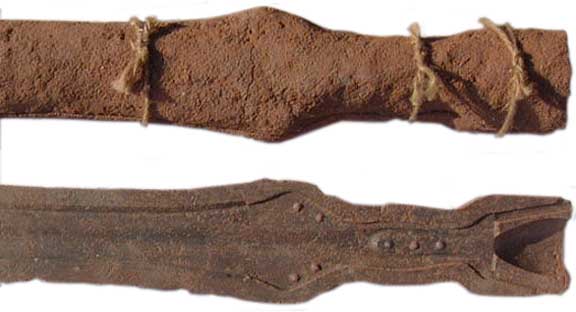
Author’s experiments with clay moulds.
The broken pieces of swords from failed castings, in founder’s hordes showed that they did not core the holes in the handle, but made shallow dimples in the mould instead. These are less likely to break the flow of bronze through the handle during casting, with the holes being drilled or punched in the sword afterwards. The two clay shells would need to be lined up, so there is no misalignment during casting. I think the easiest way would have been to trim the shoulders of the mould to an even width all the way round, i.e. from the blade edge to the mould edge, once lined up the two sides could be tied together and the reinforcing sticks added, if not used earlier.
To hold the shells together during firing and to prevent the bronze running out of the mould you need to surround the shells with a clay jacket with a high dung content and it would be sensible to build it up in layers after each one dries.
Once the mould has dried, one has to think about firing the mould and casting it all at the same time. Our Bronze Age metal smith probably had a firing pit near the furnace. He would have very slowly brought the mould up to around 600c, too hot too quick, and the mould would break: weeks of work gone in seconds. What casting a sword was like we will never know, but maybe the following passage might give you insight.
The Pool of Orange Light
The inside of the round house seemed quiet, the thick granite walls and thatched roof insulated them from the comings and goings outside: for a while this was a private space for the chosen few.
The old man paces back and forth across the dirt floor of the round house, like the accused awaiting judgement. Showers of sparks rise with each blast of the bellows in the smoke and darkness above their heads. This is their third attempt and the deadline approaches. ’What have I done to upset the gods like this.’ he wonders. Looking down through the flames into the furnace, his face glows from the light. The three other men watch his every move, waiting on his word.
They had been bellowing for what felt like ages,’ It’s time’ he says. Two of the assistants move quickly. Using sticks which start to burn; they manoeuvre the hot mould from the fire and stand it in a hole in the ground. The third person starts raking back the charcoal from the furnace.
He looks to the old man for reassurance, the old man nods. The heat from the furnace is intense, almost unbearable. With large animal skins wrapped around his arms to shield him, he uses wooden tongs to tease the white-hot crucible out of the glowing coals. Lifting it free from the fire he holds the crucible next to the mould.
One of the helpers holds a flat stick across the lower edge of the crucible to dam the charcoal that floats on the surface. He starts to pour, the metal runs out under the stick. Thoughts race through his head, if the mould cracks the metal will splash across the floor around their feet. If it leaks, will there be enough bronze to fill the mould?
He pours for what seems like an eternity. This is the time when the gods feed on your soul. They watch the golden liquid pouring into the mould, it only takes on tiny piece of charcoal to get washed in and the sword is ruined, the mould fills to the top.
The pool of orange metal sits there, they stare into the orange as if it were a window to the next world. Gradually the pool sinks as the metal sets. No one dares to break the silence, as if forces that control both worlds hold sway over the sword. The old man has been here many times before but it never gets any easier, this is the price for pouring the sun’s blood.
They wait until the mould cools enough to be dipped in the water. They push the doors open slowly and the soft light of the day streams in though the smoke. Trapping the mould between two sticks they carry it outside to a wooden trough. As they lower it in it spits and pops, so many different smells of burning. The water wins its fight against the heat, the hissing stops. With steam rising from the mould they tap the clay off, the sword emerges. The younger men start talking excitedly the sword looks good but the old man is more cautious, “wait”, he says, “wash it”. They wash off the last of the mould fragments.
He looks carefully along the blade for holes and bits of charcoal trapped in the bronze, he checks to see if both sides of the blade line up, he lifts the blade from the water and wipes it. Holding it up at arm’s length he turns his wrist slowly from side to side and looks along the blade. The sun glints on the wet bronze, his face softens, it is a beauty.
‘May the gods be praised!’